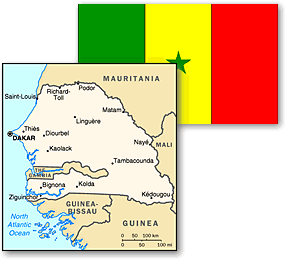Snapshot of Senegal
Location:
Senegal wraps around its smaller neighbor, The Gambia, to form the
western bulge of
Africa. It has a 330 mile coastline on the Atlantic. Mauritania and Mali
are north and
east and Guinea and Guinea-Bissau border on the south.
Land Area:
Senegal covers approximately 76,000 square miles, roughly equivalent
in size to South
Dakota.
Terrain:
The flat rolling plains in the northern region of the country are part
of the Sahel
desert. In the southeast plateaus rise from the foothills of the Gouta
Djallon Mountains.
Marshy swamps and tropical forests are found in southwest Senegal. The
country's four main
rivers are the Senegal, Saloum, Casamance and Gambia.
Climate:
The climate is as varied as the terrain. There are two seasons, rainy
and dry. The
rainy season lasts from June through October. Along the coast the weather
tends to be
breezy and cooler while further inland it is drier in the north and more
tropical in the
south. Temperatures range from 64 to 86 degrees.
Population:
There are around 7 million people. The population is made up of
numerous ethnic groups
that include Wolof 36%, Fulani 17%, Serer 17%, Toucouleur 9%, Diola 9%,
Mandingo 9%,
European and Lebanese 1%, other 2%
Language:
French is the official language. Other languages spoken are Wolof,
Pulaar, Serer, Diola
and Mandingo.
Religion:
Muslim 92%, indigenous beliefs 6%, Christian 2%
Major Cities:
Dakar is the nation's capital and its largest city. Other major cities
are Saint Louis,
which served as the colonialist capital, and Thiés, Kaolack and
Ziguinchor.
Government:
After achieving independence from France in 1960, Senegal was
established as a
republic. Its constitution was adopted in 1963. The president, elected
every five years,
is head of state and appoints a council of ministers as well as Supreme
Court judges. The
legislature, the National Assembly, is a unicameral body with 120 elected
members.
President Abdou Diouf is leader of the Socialist Party, which has been
the party in power
since 1960.
Economy:
The economy of Senegal is relatively diversified. The main
agricultural crop is
groundnuts. Other crops are maize, millet, beans, rice, sugar and cotton.
Industries
include textile manufacturing and food processing as well as petroleum
and phosphate
production. Fishing industries have become the largest export earner.
Tourism is also a
growing sector of the economy.
Flag:
The national banner consists of three vertical bands of green, yellow
and red. A green
star is centered in the yellow band.

![]()


![[White House icon]](/New/images/home_pin.gif)
![[Help Desk icon]](/New/images/help_pin.gif)